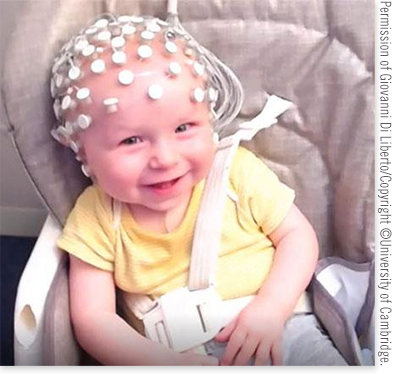A Deep Dive into the Power of Rhymes | First Steps
Singsong language is good for infant brains, according to new research.
 |
A young participant in Trinity College Dublin's study of how babies process phonetic information. |
Whenever I lead a baby story time and the crowd gets squirmy, I start singing. It works like magic to refocus the group. Now there may be new research that supports this. A University of Cambridge and Trinity College Dublin study found that babies don’t begin to process phonetic information reliably until seven months. Previous studies on early language acquisition focused on the ability to hear differences between pairs of syllables—for example: /ba/ vs. /ga/. The new study, led by Trinity assistant professor Giovanni Di Liberto, suggests that babies detect phonological categories—the smallest units of speech, typically represented by the alphabet—from a very early age.
This result is part of a larger line of study investigating the importance of rhythmic sounds, such as nursery rhymes, for speech development. Rhythm helps babies learn language by emphasizing the boundaries between words and syllables, making rhythmic speech both attention-grabbing and instrumental for understanding spoken language in the first few months of life. And what is more rhythmic than songs and nursery rhymes?
[Also read: "How to Encourage Voting Through Story Time | First Steps"]
Research on infants is challenging, since there’s no way to ask them about their thought processes, and research methods need to be very gentle. But electroencephalography technology, such as head caps with sensors that can measure brain activity, allows for amazing discoveries. In Di Liberto’s study, which appeared in Nature Communications in December 2023, researchers recorded the brain activity of 50 infants at four, seven, and eleven months as they watched a video of a teacher singing 18 nursery rhymes to an infant. An algorithm let researchers record the phonological information the participants were responding to. The pattern began to look more adultlike after seven months of age. The authors concluded that the study offers evidence that “the human cortex displays a progressive increase in phonetic encoding during nursery rhyme listening across the first year of life.” The implication: at seven months, infants can already detect phonological information in singsong rhythms, where the rhythmic information supports that.
This speaks to the vital importance of library programs for the very young to help model songs and rhymes to families. And when sharing songs and rhymes, to explain why they’re vital: “New research shows that the rhythmic and singsong nature of rhymes and songs support language development in the first few months of life. Be sure to sing these at home with your baby!” This gives credibility to early learning tips and may prompt parents and caregivers to engage in these activities frequently.
Lean into selecting books for the very young that have rhythmic, rhyming language, rather than prose narratives. Or look for titles you can sing. Brown Bear, Brown Bear, What Do You See? by Bill Martin Jr., illustrated by Eric Carle (Holt, 1967), can be sung to the tune of “Twinkle, Twinkle Little Star.” Publishers may also want to take note of this research and create board books for the very young with more rhythmic language, rather than alphabet books or titles with images captioned by single words.
Meanwhile, children’s librarians and music educators have been concerned about the troubling legacies of many traditional songs and rhymes and are rethinking the early childhood canon. Traditional tunes like “Turkey in the Straw” or “Ten Little Indians,” used in racist minstrel shows, are the basis for popular baby story time songs like “Ten Little Bubbles” or “The Elevator Song.” Use your librarian research skills to learn if your favorites are rooted in painful and demeaning stereotypes and find traditional or new alternatives that are just as playful.
Di Liberto’s team is also using its brain- and language-charting strategies to explore early signs of dyslexia, how bilingual babies acquire multiple languages, the relationship between dialog and social anxiety, and how musical perception and enjoyment are experienced in the brain. As this fascinating research continues under the head caps, early learning professionals should surely stay tuned.
Rachel G. Payne is coordinator of early childhood services at Brooklyn Public Library. She thanks Giovanni Di Liberto and Betsy Diamant-Cohen for their assistance with this article.
RELATED
The job outlook in 2030: Librarians will be in demand
The job outlook in 2030: Librarians will be in demand
ALREADY A SUBSCRIBER? LOG IN
We are currently offering this content for free. Sign up now to activate your personal profile, where you can save articles for future viewing






Add Comment :-
Be the first reader to comment.
Comment Policy:
Comment should not be empty !!!